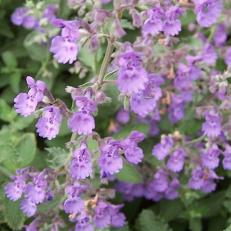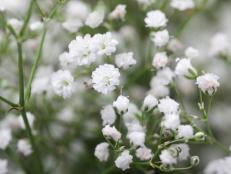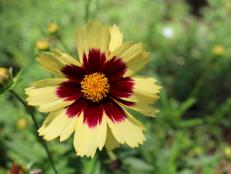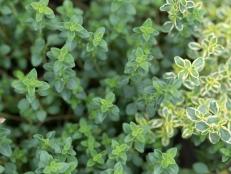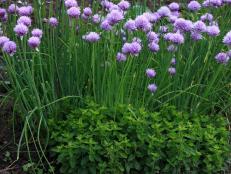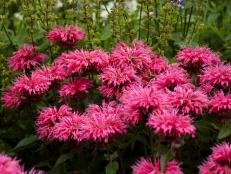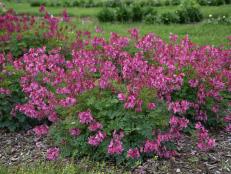How to Plant and Grow Catmint
Catmint plants dress up borders, paths and rock gardens with their lovely lavender, pink or white blooms. Use them as "shoes" for your roses or let them spill over walls. You can even brew their leaves into a minty tea.
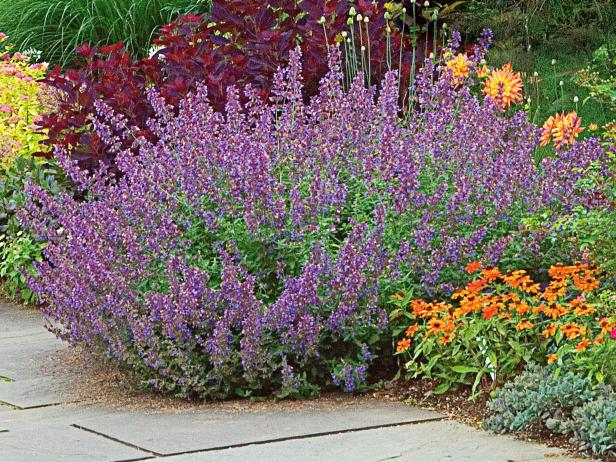
White Flower Farm
Versatile catmint complements almost any garden style, whether you're growing hybrid roses, herbs or native perennials.

If you've ever grown catnip for your feline friends, you've grown a type of catmint (Nepeta spp). Both are in the mint family, but catmint is a long-lived perennial with pretty flowers and a light aroma, while catnip (Nepeta cataria) is weedier and smells pungent (but cats love it).
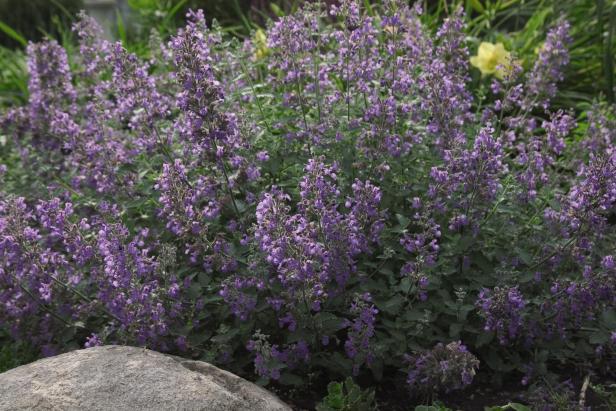
Bailey Nurseries, Inc.
'Walker's Low' catmint benefits from shearing after its first flush of lavender-blue blooms.
Catmint 101
Botanical Name: Nepeta spp.
Common Name: Catmint
Hardiness Zones: 3 to 8
Bloom Time: Most bloom from late spring into midsummer
Bloom Color: Lavender-blue, pink or white
Uses: Borders, paths and rock gardens
Fast-growing catmint doesn't need much care. Add its pink, white or lavender-blue flowers to herb beds and borders or grow it along walkways and in pollinator gardens where it will attract bees and butterflies. Let it spread as a ground cover to control erosion or use a dwarf variety in a container.
Catmint is also great for rock gardens and helps hide the trunks of hybrid roses. Some people use the minty-flavored leaves in herbal teas or salads. (Never use any parts of catmint plants that have been treated with chemicals.) Most catmint plants are hardy in USDA Gardening Zones 3 to 8.
How to Use Catmint
Roses and catmint plants are a popular combination. Catmint's flowering stems help hide bare rose stems. Catmints are also lovely with other perennials that like full sun and tolerate drought, such as verbena, salvia, yarrow, lavender and Agastache. Ornamental or native grasses, sedums, spiky yuccas and pointy-leaved irises contrast nicely with them. Grow catmints in an herb bed with rosemary, oregano and thyme. In addition to being used for herbal tea, some gardeners toss them into salads (again, use only catmints that have never been treated with chemicals). Also try catmints with peonies, snapdragons, dianthus and foxgloves.
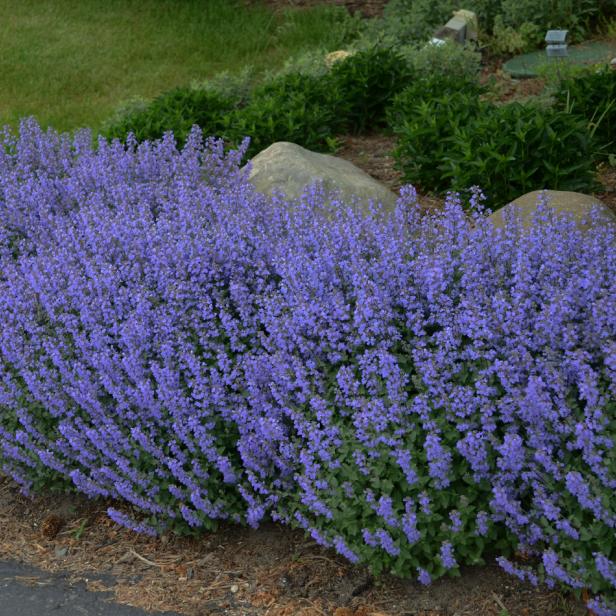
PerennialResource.com
The odor of catmint plants like this Nepeta faassenii 'Purrsian Blue' are said to help repel mosquitoes.
How to Grow Catmint
Planting Catmint
Plant catmint in your garden after the last spring frost while the weather is still cool, or wait until temperatures drop in fall.
- Loosen the soil and remove rocks, sticks and other debris.
- Dig a hole a little wider and deeper than the plant's roots. If the roots are tangled, gently loosen them.
- Lower the plant into the hole so the base is at soil level.
- Backfill the hole, gently press down on the soil to eliminate any air pockets and water thoroughly.
Light Needs
A site that gets six hours of full sun each day is ideal, but catmint will grow in partial sun. If you live where the summer sun is intense, choose a site that gets some afternoon shade.
Soil Requirements
Give catmint well-draining soil. It adapts to almost any kind, whether it's clay-like, sandy or rocky. It isn't picky about pH.
How to Water
Until it's established, catmint should be watered regularly during its first growing season. After that, water as needed in very hot weather or long dry spells. Catmint often blooms better and smells stronger when on the dry side. Potted catmint, however, needs regular watering or rainfall so its soil stays evenly moist.
Fertilizer Needs
Mulch new catnip plants lightly with compost. After that, catmint plants need little or no fertilizer.
How to Plant Catmint in Containers
Catmint is drought-tolerant and nearly carefree. It's not considered invasive, like common mint. But, if you don't want it to spread, plant it in containers with large drainage holes and good potting soil. When roots start growing out of the holes, move your plant to a bigger container or divide it.
Buy Catmint
Catmint Pests and Diseases
Pests and diseases rarely bother catmint, and its strong aroma discourages deer and rabbits.
How to Propagate Catmint
You can propagate catmint plants by division or from cuttings. For divisions, use a spade to slice vertically into plants with established root systems and new shoots. Carefully dig up the sliced pieces and replant them. Don't forget to replace the soil around the original plants, so the roots aren't exposed. Thoroughly water the new divisions and keep them moist for about a month or until new growth appears.
To make more plants from cuttings, cut sections of stems from healthy plants in late spring or early summer. Remove the leaves from the lower half of the stems and place the stems in a jar of water or a container of moist potting soil.
Place the cuttings in a brightly lit spot out of the direct sun. Keep the soil moist or change the water in the jar every few days. In about two weeks, new growth should emerge from the potted cuttings and roots should form on the cuttings in water.
It's also easy to grow catmint from seeds. Just be aware that if you collect seeds from a hybrid variety, you won't get plants that look exactly like the parent. You may want to buy seeds instead.
Sow the seeds indoors in a seed-starting mix six to eight weeks before your last spring frost. Press them down gently and barely cover them with soil; they won't germinate if they don't get any light. When the seedlings are 2 or 3 inches tall, pinch the growing tips to encourage bushy growth. After there's no more danger of frost, transplant them into the garden or containers.
How to Overwinter Catmint
If you're growing a variety that's hardy in your garden zone, catmint plants in the ground should overwinter without any special care. Bring container-grown plants inside when the temperatures drop in the fall. Keep them near a bright window, but out of the direct sun, in a cool place or in an unheated garage or basement. Water them less than usual but don't let them go dry. They'll go dormant and re-grow when it's warm enough to move them back outside.
How to Prune Catmint
If your plant grows out of bounds, shear it back after the flowers bloom. You'll usually get a second flush of catmint flowers, although fewer than before. Shearing also encourages the plants to become bushy instead of tall and leggy.
Varieties of Catmint to Grow
'Blue Wonder' (Nepeta racemosa) — At 9 to 18 inches high and 12 to 18 inches wide, 'Blue Wonder' is a spreading, clumping variety with blue flowers and gray-green leaves. Its seeds are sterile, but you can propagate the plants, which are hardy in Zones 3 to 8, by division.
'Pink Cat' (Nepeta nervosa 'Pink Cat') — Prefer a pink catmint flower? This plant produces lots of them on spikes that rise above mounds of dark green foliage. The mounds stay compact, reaching just 6 inches tall and 12 inches wide, so you can use them in beds, borders or containers. Grow this catmint flower in Zones 4 to 9.
'Neptune' (Nepeta kubanica 'Bokratune') — Pollinators love this new dwarf catmint, which grows to 14 inches tall and 12 inches wide. Hardy in Zones 4 to 9, it has big, green leaves and violet-blue blooms in the summertime.
'Six Hills Giant' (Nepeta) — This is one of the tallest catmints, growing to 3 feet in Zones 3 to 8. Its deep violet-blue blooms don't produce seeds and open from early to late summer. Shear it after the flowers finish for a repeat show.
'Walker's Low' (Nepeta x faassenii 'Walker's Low') — This variety has periwinkle blue flowers from late spring to late summer and forms compact mounds of gray-green, heart-shaped leaves. Hardy in Zones 4 to 9, it's a sterile variety. It reaches about 24 inches tall with a 24- to 36-inch spread.
'Alba' (Nepeta faassenii 'Alba') — Hardy in Zones 4 to 9, grow this variety for its white catmint flowers and heart-shaped leaves. It matures 12 to 18 inches tall and 12 to 24 wide. Watch for the blooms to appear from summer to early fall; the plants may rebloom if they're cut back.
'Cat's Meow' (Nepeta faassenii) — 'Cat's Meow' has deep lavender-blue catmint flowers and upright stems that resist flopping. It forms spreading mounds and works nicely in containers and mass plantings. Recommended for Zones 3 to 8, it grows 17 to 20 inches high and spreads 24 to 36 inches.
'Junior Walker' (Nepeta x faassenii 'Novanepjun') — Finely textured, gray-green foliage and soft lavender blooms make this catmint a standout. It's a sterile, dwarf variety for Zones 5 to 9. It matures at 14 to 16 inches tall and spreads 30 to 36 inches wide.
'Whispurr Blue' (Nepeta x faassenii 'Balpurrlu') — At 24 to 28 inches tall and up to 22 inches wide, this variety has lilac-purple catmint flowers that open in late spring. It's hardy in Zones 4 to 9.
'Purple Haze' (Nepeta) — Maturing at just 4 inches tall with a 30-inch spread, this catmint forms a silvery mat that you can use as a groundcover, on banks, in rock gardens or in the fronts of borders. The big, purple-blue flowers open from summer into fall. It's unusual because it's hardy only in Zones 6 to 10.

.-Battle-on-the-Beach-courtesy-of-HGTV.-.jpg.rend.hgtvcom.196.196.suffix/1714761529029.jpeg)





